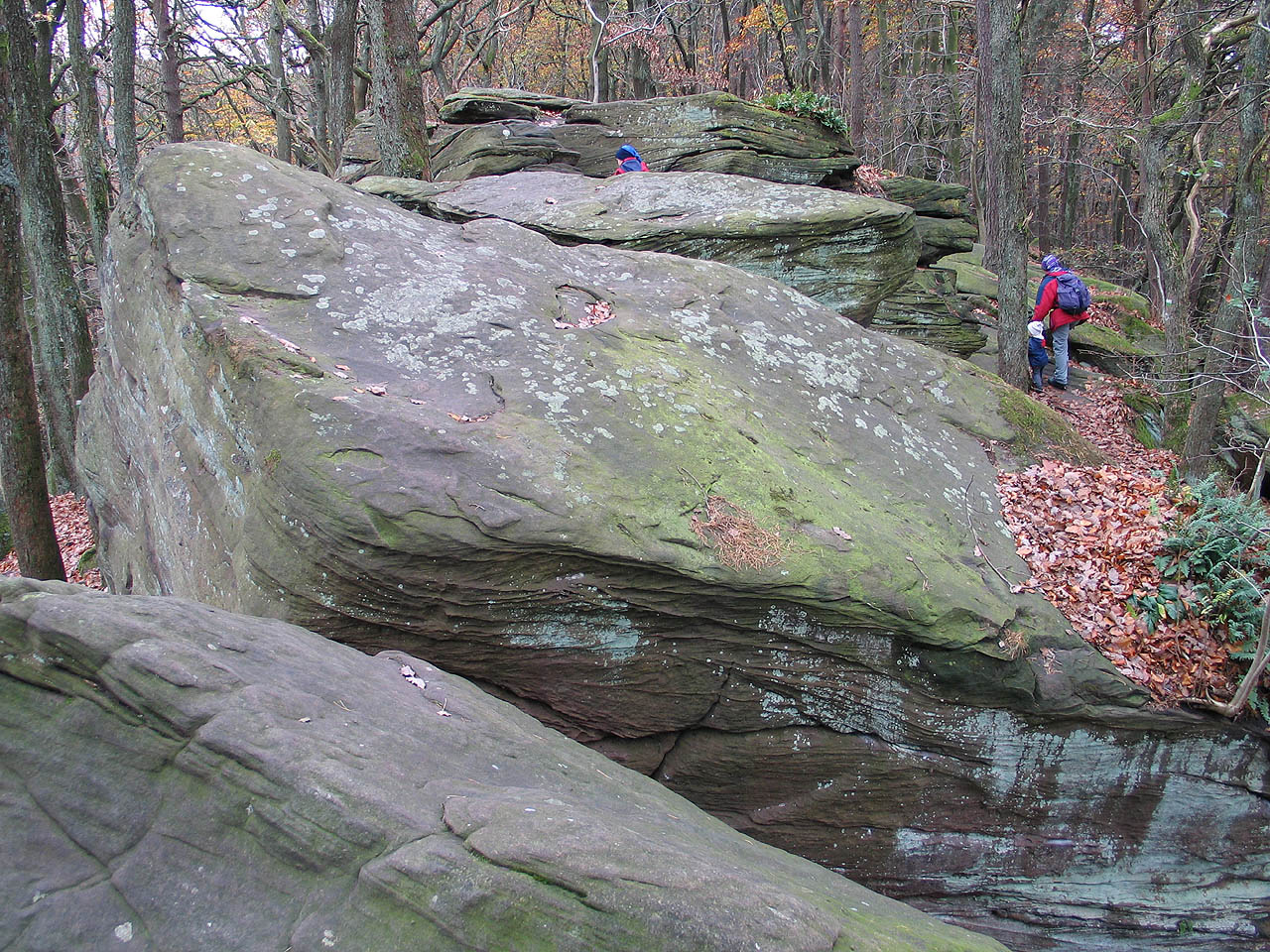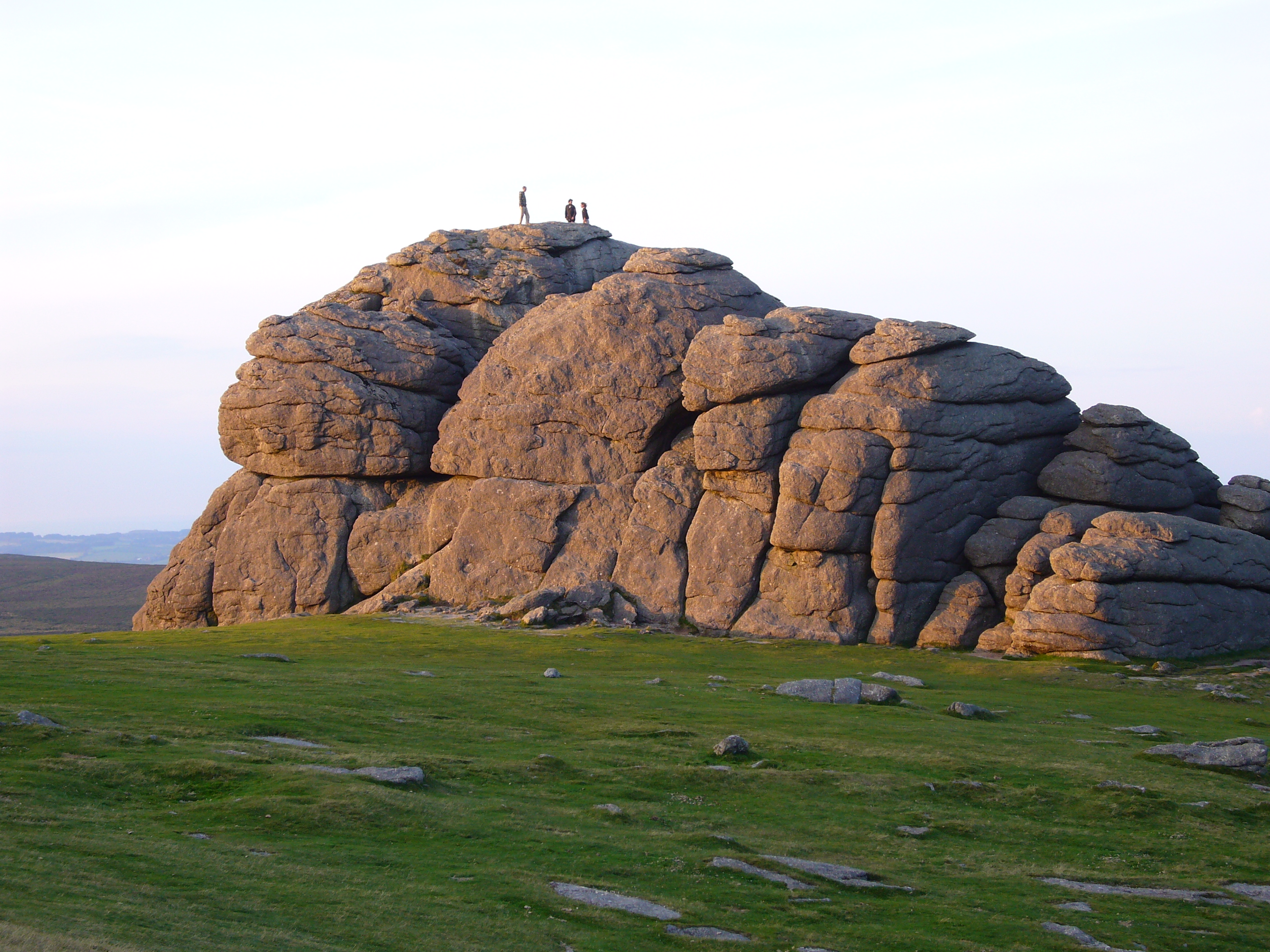|
Luisenburg Rock Labyrinth
The Luisenburg Rock Labyrinth (german: Luisenburg-Felsenlabyrinth) is a felsenmeer made of granite blocks several metres across and is part of the ''Großes Labyrinth'' Nature Reserve near Wunsiedel in Germany. For a long time its formation was believed to have been caused by natural disasters such as earthquakes. Today it is known that processes such as weathering and erosion over a long period are much more likely to have been responsible for the formation of the rock labyrinth. Goethe wrote in 1820 The well-rounded shapes of the individual blocks were formed by spheroidal weathering (''Wollsackverwitterung'') in the tropical, humid climate of the Cenozoic era. Over the course of time they were left behind as the ground around was eroded; they became unstable and began to shift. This resulted in the jumble of rocks with wild, romantic paths through the narrow clefts and steep steps. Tourism The jumble of rocks (a blockfield) named after Queen Louise was already being expl ... [...More Info...] [...Related Items...] OR: [Wikipedia] [Google] [Baidu] |
Natural Monument
A natural monument is a natural or natural/cultural feature of outstanding or unique value because of its inherent rarity, representative of aesthetic qualities or cultural significance. Under World Commission on Protected Areas guidelines, natural monuments are level III, described as: :"Areas are set aside to protect a specific natural monument, which can be a landform, sea mount, submarine cavern, geological feature such as a cave or even a living feature such as an ancient grove. They are generally quite small protected areas and often have high visitor value." This is a lower level of protection than level II (national parks) and level I (wilderness areas). The European Environment Agency's guidelines for selection of a natural monument are: * The area should contain one or more features of outstanding significance. Appropriate natural features include waterfalls, caves, craters, fossil beds, sand dunes and marine features, along with unique or representative fauna and flo ... [...More Info...] [...Related Items...] OR: [Wikipedia] [Google] [Baidu] |
Christian Felix Weiße
Christian Felix Weiße (1726–1804) was a German writer and pedagogue. Weiße was among the leading representatives of the Enlightenment in Germany and is regarded as the founder of German children's literature. Life Weiße was born as twin on 28 January 1726 in Annaberg in the Ore Mountains as the son of Christian Heinrich Weiße and his wife, Christian Elisabeth. His father was rector at a Latin school and teacher for oriental and modern European languages. When Weiße was one year old, the family moved to Altenburg, Thuringia, 45 km south of Leipzig, where he then attended the Gymnasium and made his first attempts at writing poetry. His father had died in 1730. His family moved then to Leipzig, where he studied philology and theology from 1745 until 1750 at the University of Leipzig. During this time, he became acquainted with Christian Fürchtegott Gellert, Gotthold Ephraim Lessing, Friederike Caroline Neuber, Gottlieb Rabener and Ewald Christian von Kleist. After ... [...More Info...] [...Related Items...] OR: [Wikipedia] [Google] [Baidu] |
Johann Adam Hiller
Johann Adam Hiller (25 December 1728, in Wendisch-Ossig, Saxony – 16 June 1804, in Leipzig) was a German composer, conductor and writer on music, regarded as the creator of the Singspiel, an early form of German opera. In many of these operas he collaborated with the poet Christian Felix Weiße. Furthermore, Hiller was a teacher who encouraged musical education for women, his pupils including Elisabeth Mara and Corona Schröter. He was Kapellmeister of Abel Seyler's theatrical company, and became the first Kapellmeister of Leipzig Gewandhaus. Biography By the death of his father in 1734, Hiller was left dependent to a large extent on the charity of friends. He came from a musical family, and also learned the basics of music from a school master in his home town, Wendisch-Ossig. From 1740 to 1745, he was a student at the Gymnasium in Görlitz, where his fine soprano voice earned him free tuition. In 1746 he went to study at the famous Kreuzschule in Dresden. There he took key ... [...More Info...] [...Related Items...] OR: [Wikipedia] [Google] [Baidu] |
Singspiel
A Singspiel (; plural: ; ) is a form of German-language music drama, now regarded as a genre of opera. It is characterized by spoken dialogue, which is alternated with ensembles, songs, ballads, and arias which were often strophic, or folk-like. Singspiel plots are generally comic or romantic in nature, and frequently include elements of magic, fantastical creatures, and comically exaggerated characterizations of good and evil. __TOC__ History Some of the first Singspiele were miracle plays in Germany, where dialogue was interspersed with singing. By the early 17th century, miracle plays had grown profane, the word "Singspiel" is found in print, and secular Singspiele were also being performed, both in translated borrowings or imitations from English and Italian songs and plays, and in original German creations. In the 18th century, some Singspiele were translations of English ballad operas. In 1736, the Prussian ambassador to England commissioned a translation of the ballad op ... [...More Info...] [...Related Items...] OR: [Wikipedia] [Google] [Baidu] |
Frederick William III Of Prussia
Frederick William III (german: Friedrich Wilhelm III.; 3 August 1770 – 7 June 1840) was King of Prussia from 16 November 1797 until his death in 1840. He was concurrently Elector of Brandenburg in the Holy Roman Empire until 6 August 1806, when the Empire was dissolved. Frederick William III ruled Prussia during the difficult times of the Napoleonic Wars. The king reluctantly joined the coalition against Napoleon in the . Following Napoleon's defeat, he took part in the Congress of Vienna, which assembled to settle the political questions arising from the new, post-Napoleonic order in Europe. His primary interests were internal – the reform of Prussia's Protestant churches. He was determined to unify the Protestant churches to homogenize their liturgy, organization, and architecture. The long-term goal was to have fully centralized royal control of all the Protestant churches in the Prussian Union of Churches. The king was said to be extremely shy and indecisive. His wife ... [...More Info...] [...Related Items...] OR: [Wikipedia] [Google] [Baidu] |
Louise Of Mecklenburg-Strelitz
Duchess Louise of Mecklenburg-Strelitz (Luise Auguste Wilhelmine Amalie; 10 March 1776 – 19 July 1810) was Queen of Prussia as the wife of King Frederick William III. The couple's happy, though short-lived, marriage produced nine children, including the future monarchs Frederick William IV of Prussia and Wilhelm I, German Emperor. Her legacy became cemented after her extraordinary 1807 meeting with French Emperor Napoleon I at Tilsit – she met with the emperor to plead unsuccessfully for favorable terms after Prussia's disastrous losses in the Napoleonic Wars. She was already well loved by her subjects, but her meeting with Napoleon led Louise to become revered as "the soul of national virtue". Her early death at the age of thirty-four "preserved her youth in the memory of posterity", and caused Napoleon to reportedly remark that the king "has lost his best minister". The Order of Louise was founded by her grieving husband four years later as a female counterpart ... [...More Info...] [...Related Items...] OR: [Wikipedia] [Google] [Baidu] |
Blockfield
A blockfieldWhittow, John (1984). ''Dictionary of Physical Geography''. London: Penguin, 1984, pp. 66 and 190. . (also spelt block fieldLeser, Hartmut, ed. (2005). ''Wörterbuch Allgemeine Geographie'', 13th ed., dtv, Munich, pp. 107 and 221. . ), felsenmeer, boulder field or stone field is a surface covered by boulder- or block-sized angular rocks usually associated with alpine and subpolar climates and periglaciation. Blockfields differ from screes and talus slope in that blockfields do not apparently originate from mass wastings. They are believed to be formed by frost weathering below the surface. An alternative theory that modern blockfields may have originated from chemical weathering that occurred in the Neogene when the climate was relatively warmer. Following this thought the blockfields would then have been reworked by periglacial action. Most known blockfields are located in the northern hemisphere. Examples can be found in Abisko National Park in Sweden, Snowdonia ... [...More Info...] [...Related Items...] OR: [Wikipedia] [Google] [Baidu] |
Cenozoic
The Cenozoic ( ; ) is Earth's current geological era, representing the last 66million years of Earth's history. It is characterised by the dominance of mammals, birds and flowering plants, a cooling and drying climate, and the current configuration of continents. It is the latest of three geological eras since complex life evolved, preceded by the Mesozoic and Paleozoic. It started with the Cretaceous–Paleogene extinction event, when many species, including the non-avian dinosaurs, became extinct in an event attributed by most experts to the impact of a large asteroid or other celestial body, the Chicxulub impactor. The Cenozoic is also known as the Age of Mammals because the terrestrial animals that dominated both hemispheres were mammalsthe eutherians (placentals) in the northern hemisphere and the metatherians (marsupials, now mainly restricted to Australia) in the southern hemisphere. The extinction of many groups allowed mammals and birds to greatly diversify so that l ... [...More Info...] [...Related Items...] OR: [Wikipedia] [Google] [Baidu] |
Felsenmeer
A blockfieldWhittow, John (1984). ''Dictionary of Physical Geography''. London: Penguin, 1984, pp. 66 and 190. . (also spelt block fieldLeser, Hartmut, ed. (2005). ''Wörterbuch Allgemeine Geographie'', 13th ed., dtv, Munich, pp. 107 and 221. . ), felsenmeer, boulder field or stone field is a surface covered by boulder- or block-sized angular rocks usually associated with alpine and subpolar climates and periglaciation. Blockfields differ from screes and talus slope in that blockfields do not apparently originate from mass wastings. They are believed to be formed by frost weathering below the surface. An alternative theory that modern blockfields may have originated from chemical weathering that occurred in the Neogene when the climate was relatively warmer. Following this thought the blockfields would then have been reworked by periglacial action. Most known blockfields are located in the northern hemisphere. Examples can be found in Abisko National Park in Sweden, Snowdonia ... [...More Info...] [...Related Items...] OR: [Wikipedia] [Google] [Baidu] |
Spheroidal Weathering
Spheroidal weathering is a form of chemical weathering that affects jointed bedrock and results in the formation of concentric or spherical layers of highly decayed rock within weathered bedrock that is known as '' saprolite.'' When saprolite is exposed by physical erosion, these concentric layers peel (spall) off as concentric shells much like the layers of a peeled onion. Within saprolite, spheroidal weathering often creates rounded boulders, known as ''corestones'' or ''woolsack'', of relatively unweathered rock. Spheroidal weathering is also called onion skin weathering, concentric weathering, spherical weathering, or woolsack weathering.Fairbridge, RW (1968) ''Spheroidal Weathering.'' in RW Fairbridge, ed., pp. 1041–1044, The Encyclopedia of Geomorphology, Encyclopedia of Earth Sciences, vol. III. Reinhold Book Corporation, New York, New York. Ollier, C.D. (1971). ''Causes of spheroidal weathering. ''Earth-Science Reviews 7:127–141.Neuendorf, KKE, JP Mehl Jr., and JA ... [...More Info...] [...Related Items...] OR: [Wikipedia] [Google] [Baidu] |
_db.jpg)
.jpg)



_crop.jpg)




